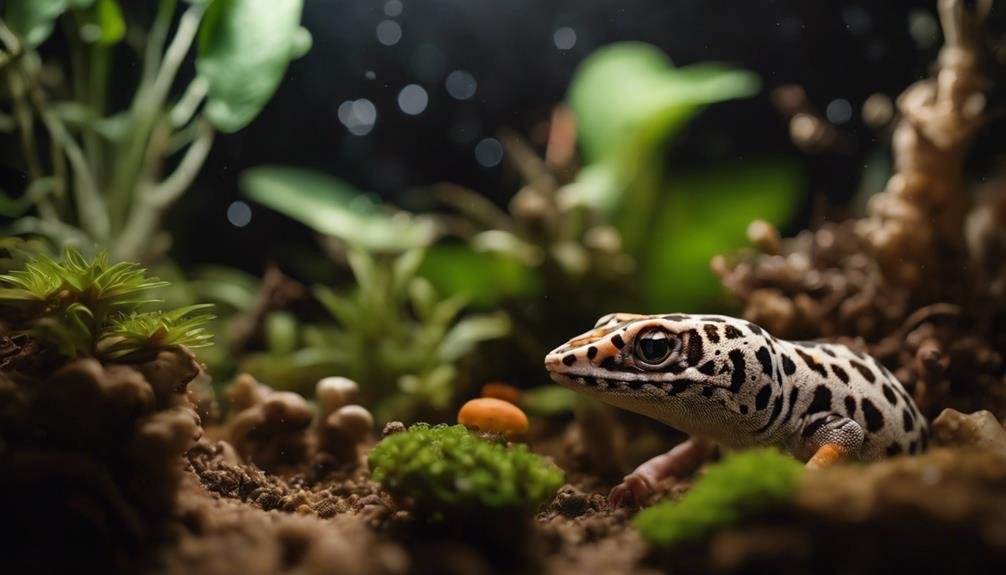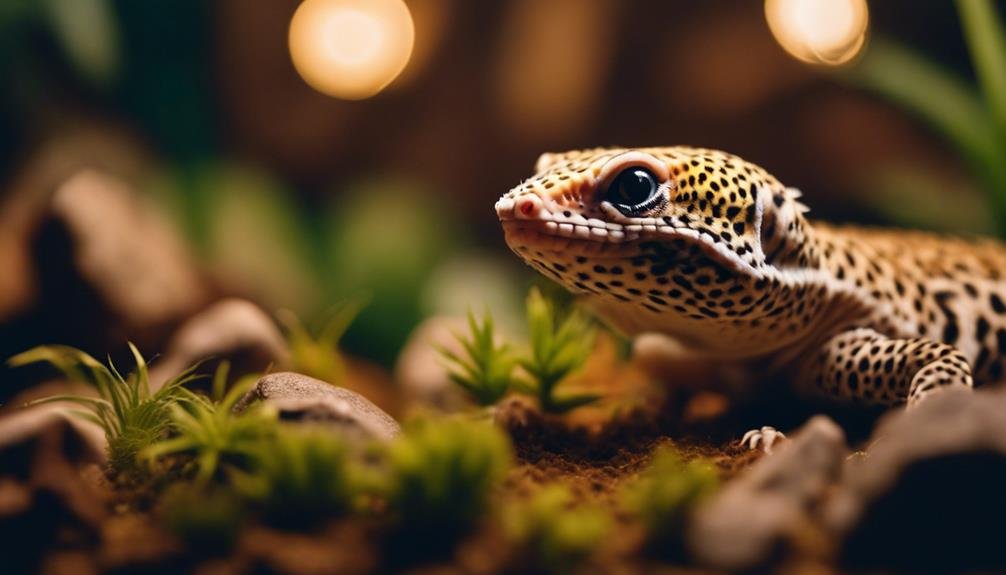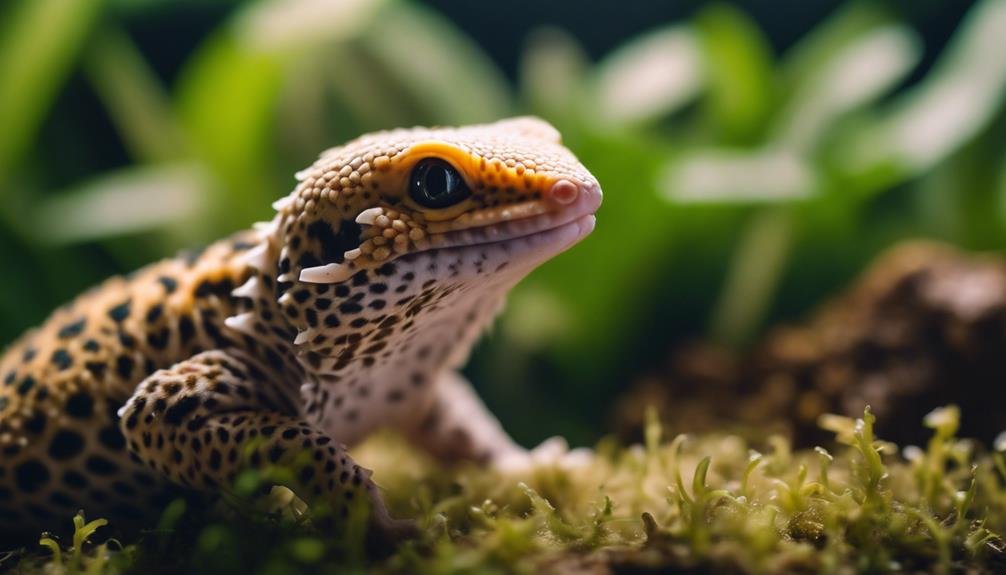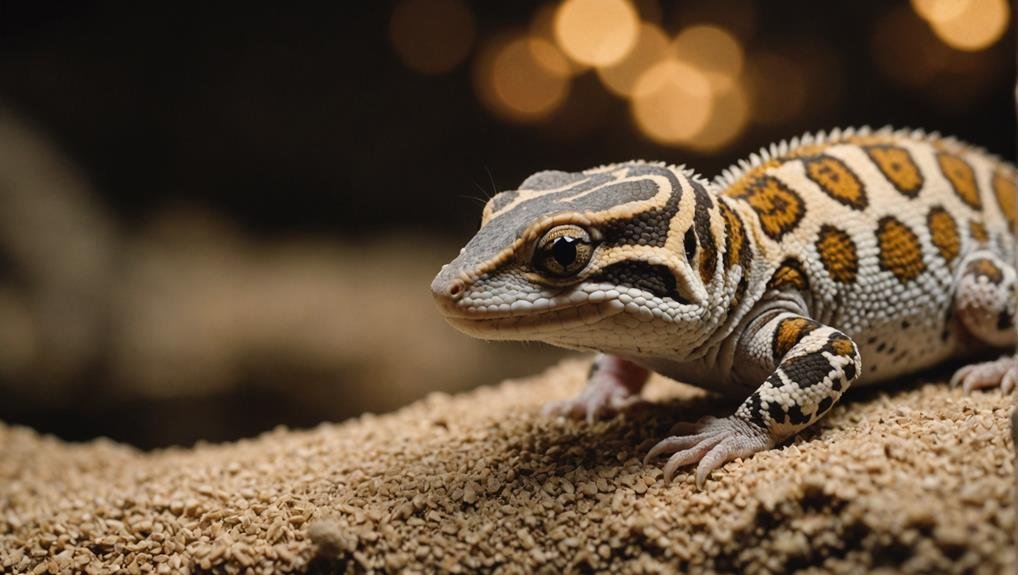Choosing the best substrate for your leopard gecko is essential for their health and happiness. You’ve probably heard about bioactive-ready substrates, which create a mini-ecosystem within the terrarium. These mimic their natural habitat and help break down waste, making maintenance easier. But what about DIY substrate mixes or the safety of loose substrates? There’s much to consider, and each option has benefits and drawbacks. Curious about which substrates you should avoid and why? Let’s explore the factors that will help you choose your gecko best.
Key Takeaways
- Bioactive-ready substrates offer a self-sustaining ecosystem and effectively mimic the gecko’s natural habitat.
- DIY substrate mixes are cost-effective and customizable, supporting natural tunneling and humidity balance.
- Safe, loose substrates minimize impaction risks and replicate a natural desert environment.
- Avoid unsafe substrates like calcium sand, reptile carpets, and walnut shells due to impaction and toxicity risks.
- Moist hides with sphagnum moss, essential for shedding, hydration, and overall health.
Bioactive-Ready Substrates


In summary, choosing a bioactive-ready substrate for your leopard gecko can significantly enhance its habitat by promoting a self-sustaining ecosystem. These Leopard Gecko substrate options are designed to support a bioactive setup with beneficial microorganisms that aid in waste breakdown and odor control. When searching for the best substrate, a bioactive substrate stands out for effectively effectively mimicking the geckos’ natural environment.
Utilizing a natural substrate like soil, safe sand, and clay helps create a naturalistic habitat. This benefits the gecko, making the enclosure more visually appealing and easier to clean. Naturalistic setups encourage your leopard gecko to exhibit natural behaviors, contributing to its overall well-being.
A Bioactive terrarium is a fantastic way to provide your pet with an enabling and enriching environment. By opting for a bioactive substrate, you’re investing in the geckos’ wellbeing, giving them a habitat that closely resembles their natural surroundings. These substrates offer a balanced ecosystem that supports the reptile’s natural lifestyle, promoting physical health and mental stimulation.
Choosing a bioactive-ready substrate is smart for any leopard gecko owner aiming to create a thriving, naturalistic setup.
DIY Substrate Mix
Creating your DIY substrate mix for a leopard gecko can be cost-effective and customizable. It offers a naturalistic habitat tailored to your pet’s needs. Combining organic topsoil, sand, and excavator clay creates a substrate miming the gecko’s natural environment, promoting natural behaviors like digging and burrowing.
A recommended DIY substrate mix consists of:
- 40% organic topsoil
- 40% sand
- 20% excavator clay
The organic topsoil provides essential nutrients, while the sand aids in drainage, ensuring the substrate remains dry enough to prevent humidity-related issues. Excavator clay, on the other hand, allows your leopard gecko to exhibit its natural tunneling behavior, which is important for its wellbeing.
To prepare the mix, thoroughly saturate the components and allow them to dry completely before introducing your gecko. This step is important to maintain a balanced humidity level, as leopard geckos thrive in a relatively dry environment.
A DIY substrate mix is budget-friendly and allows you to tailor the environment specifically to your gecko’s needs, ensuring a healthier and more engaging habitat.
Safe Loose Substrates


When selecting a safe loose substrate for your leopard gecko, it’s important to choose options that mimic their natural environment and minimize the risk of impaction. Impaction occurs when your reptile ingests substrate that it can’t digest, which can lead to serious health issues.
Consider using organic topsoil/sand mixes, super-fine quartz sand, or excavator clay to create a natural habitat. These options provide a textured, natural feel while being safe for your gecko.
Commercially available arid substrate mixes, such as Arid ABG mix and Exoterra Stone Desert, are excellent choices. These products are designed to replicate the leopard gecko’s natural desert environment, offering aesthetic appeal and safety.
A proper loose substrate mix can also include naturally collected desert soils, an important and natural option.
Proper substrate maintenance is crucial to guaranteeing the health and well-being of your leopard gecko. Regularly clean and replace the substrate to prevent bacterial growth and other potential hazards.
Unsafe Substrates
While knowing what substrates are safe is important, understanding which ones are unsafe is essential to guarantee your leopard gecko’s well-being. Some substrates pose significant health risks, ranging from impaction to toxicity.
Calcium sand is one of the most dangerous substrates. Its dusty nature can lead to eye irritation and, more alarmingly, an impaction risk. Your gecko might ingest it, causing a life-threatening blockage in its digestive system.
Reptile carpet may seem convenient, but it harbors bacterial growth and can catch your gecko’s toenails, leading to injuries. Similarly, ground walnut shells should be avoided. They’re dusty and sharp, and their clumping nature can cause internal damage if ingested.
Additionally, wood products like cedar and pine are toxic to leopard geckos. The oils they release can be harmful when ingested or even inhaled. Substrates like linoleum or shelf liners release harmful VOCs, posing a significant health risk.
To summarize, avoid these substrates:
- Calcium sand
- Ground walnut shells
- Reptile carpet
Ensuring your leopard gecko’s habitat is free from these materials will help you maintain a safe and healthy environment for your pet.
Moist Hide Options


A moist hide is essential for your leopard gecko to aid in shedding and maintaining proper hydration. This special hide keeps your gecko’s skin soft, making it easier for them to shed without issues.
You can use materials like sphagnum moss, a natural sponge, or a damp paper towel to create a moist hide. These materials hold moisture well and provide the perfect environment for your gecko.
Place the moist hide in a warm area of the enclosure. The warmth helps maintain the moisture level, ensuring it’s vital for shedding.
Regularly check and replace the materials to prevent mold or bacterial growth, which can harm your leopard gecko’s health. Mold and bacteria thrive in damp conditions, so monitoring the hide is important.
Terrarium Decoration
To stimulate your leopard gecko’s environment, incorporate decorations like hollow logs, branches, ledges, and plants. These elements enhance the terrarium’s visual appeal, promote natural behaviors, and provide essential enrichment.
It is important to incorporate a variety of leopard gecko terrarium decorations. Enrichment items such as tunnels, branches, and climbing structures encourage your gecko to explore and stay active, which is crucial for their physical health. Additionally, strategically placed hideouts offer security and privacy, reducing stress and fostering a sense of wellbeing.
Here are some benefits of well-planned terrarium decor:
- Security and Privacy: Hideouts ensure your gecko feels safe and can retreat when needed.
- Stimulation and Activity: Climbing structures and branches promote physical activity and mental engagement.
- Enrichment and Exploration: Diverse decor prevents boredom and encourages natural behaviors.
Arrange these decorations thoughtfully to create an engaging and stimulating habitat. Doing so will provide your leopard gecko with the necessary physical activity, mental stimulation, and security. A well-decorated terrarium contributes significantly to your gecko’s overall health and happiness, ensuring a vibrant and fulfilling life.
Conclusion
In choosing the best substrate for your leopard gecko, opt for a bioactive-ready option to create a self-sustaining habitat.
DIY mixes can also work well if you guarantee they’re safe and mimic their natural environment.
Always avoid unsafe loose substrates to keep them healthy.
Don’t forget to include a moist hide and enriching decorations.
Doing so will help your gecko thrive and exhibit natural behaviors in a stimulating, safe home.


